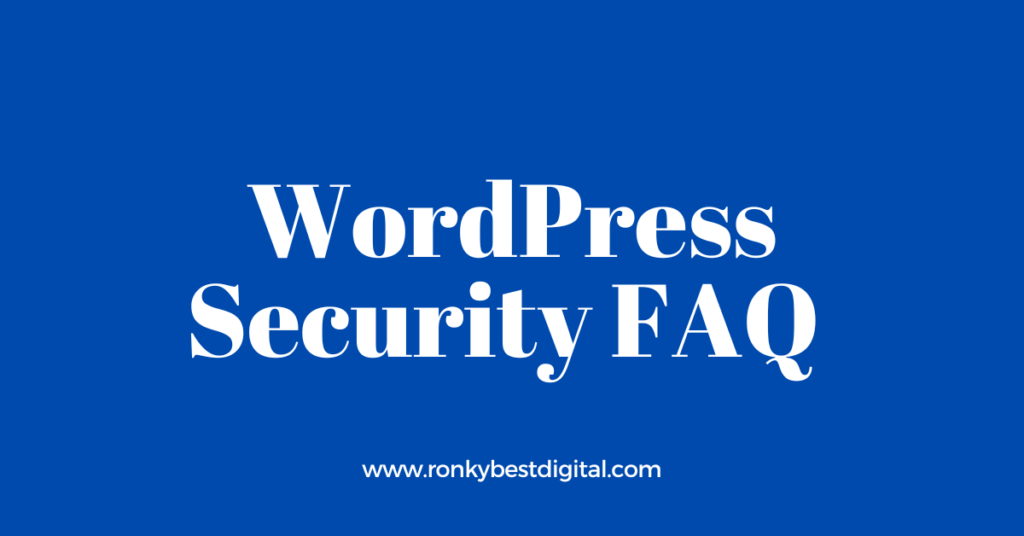WordPress Security Frequently Asked Questions (FAQ)
As the popularity of WordPress continues to soar, ensuring the security of your WordPress website has become a crucial aspect of maintaining an online presence.
In this blog post, we will address some frequently asked questions regarding WordPress website security and provide you with the best practices to secure your website effectively.
If you’re concerned about the security of your WordPress site, our WordPress security service can provide comprehensive solutions to safeguard your online presence.
Let’s dive into the FAQs!
What are the WordPress website security best practices?
WordPress website security best practices:
a. Regularly update WordPress: Stay up to date with the latest version of WordPress, as updates often include security patches that address vulnerabilities.
b. Use strong and unique passwords: Choose complex passwords for your WordPress admin account, hosting account, and any other associated accounts. Utilize password managers to generate and store strong passwords securely.
c. Implement two-factor authentication (2FA): Enable 2FA for your WordPress admin login to add an extra layer of security. This method requires you to provide a second authentication factor, such as a unique code sent to your mobile device.
d. Select reliable plugins and themes: Only install plugins and themes from trusted sources. Regularly update them and remove any unused or outdated plugins/themes.
e. Secure hosting environment: Choose a reputable hosting provider that emphasizes security measures and offers features like SSL certificates, firewall protection, and regular backups.
f. Limit login attempts: Install a plugin that limits the number of login attempts to prevent brute-force attacks on your WordPress site.
g. Use secure file permissions: Set appropriate file permissions for your WordPress files and directories to prevent unauthorized access.
h. Regularly back up your website: Create regular backups of your WordPress site to ensure you can quickly restore it in case of any security breaches or data loss.
How to secure a WordPress website:
a. Install a WordPress security plugin: Consider using a reliable WordPress security plugin that offers features like malware scanning, firewall protection, and vulnerability detection.
b. Enable SSL (Secure Sockets Layer) certificate: Encrypt the data transmitted between your website and visitors by enabling SSL. This enhances data security and helps build trust with your users.
c. Keep themes and plugins updated: Update your themes and plugins regularly to ensure you have the latest security patches and bug fixes.
d. Remove default WordPress settings: Change the default settings, such as the default username "admin," to a unique one during the WordPress installation process.
e. Monitor website activity: Regularly monitor your website's activity and log files to identify any suspicious behaviour or unauthorized access attempts.
f. Use a website firewall: Implement a website firewall to protect your WordPress site from malicious traffic, DDoS attacks, and other threats.
g. Educate yourself and your team: Stay informed about the latest security practices and educate yourself and your team on how to identify and prevent security risks.
What are the common security vulnerabilities in WordPress?
WordPress, like any other content management system, can have vulnerabilities that malicious actors may exploit. Some common vulnerabilities include outdated WordPress versions, insecure themes and plugins, weak passwords, SQL injections, cross-site scripting (XSS), and file inclusion exploits. It's crucial to stay vigilant and implement security measures to mitigate these risks.
Can I rely solely on WordPress security plugins to protect my website?
While WordPress security plugins offer valuable features and can enhance your website's security, they should not be the sole defence against threats. It's important to implement a multi-layered security approach that combines regular updates, strong passwords, secure hosting, and other best practices alongside a reliable security plugin. Plugins should be viewed as one piece of the overall security puzzle.
How often should I update my WordPress website?
Updating your WordPress website regularly is essential for maintaining its security. You should promptly apply new WordPress core updates, theme updates, and plugin updates as they become available. Aim to update your website at least once a month, if not more frequently, to ensure you have the latest security patches and bug fixes.
Are there any security measures specifically for protecting against brute-force attacks?
Yes, there are several measures you can take to protect your WordPress site against brute-force attacks. Implementing a limit on login attempts can be an effective way to discourage attackers. You can use plugins like "Limit Login Attempts" or "Login Lockdown" to restrict the number of failed login attempts from a particular IP address. Additionally, using strong passwords, enabling two-factor authentication, and changing the default "admin" username can further strengthen your defence against brute-force attacks.
How can I scan my WordPress site for malware and vulnerabilities?
WordPress security plugins often offer built-in malware scanning and vulnerability detection features. You can install a reputable security plugin like Sucuri, Wordfence, or iThemes Security, and run regular scans to identify any malware or vulnerabilities on your website. These plugins can provide detailed reports and guidance on how to address any identified issues.
Conclusion:
Securing your WordPress website is of utmost importance in today’s digital landscape. By following the best practices mentioned above, you can significantly enhance the security of your WordPress site and safeguard it from potential threats.
If you need comprehensive WordPress security solutions, our WordPress security service can provide the expertise and assistance required to protect your website effectively. Don’t compromise on your website’s security—act now to keep your online presence safe and secure.
Remember, a secure WordPress site is a resilient one!
Get in touch with us here
You may also be interested in:
Social Media Marketing Strategies to Increase Your Business’ Conversion In 2023
Search Engine Optimization for Credit Repair Companies
High Conversions Ecommerce Guide: How To Improve Ecommerce Website Conversion Rate
